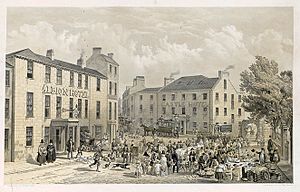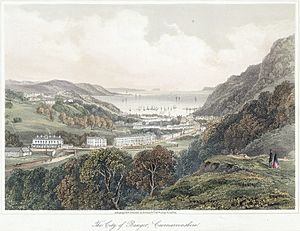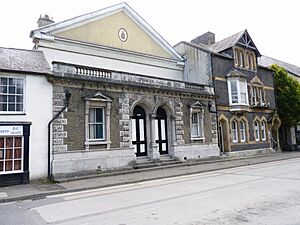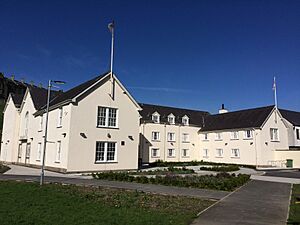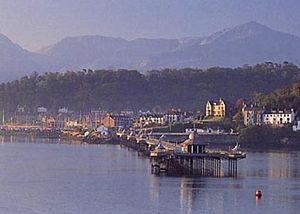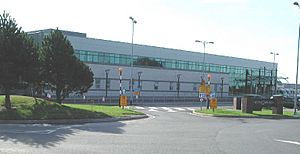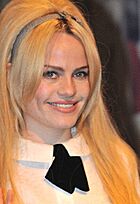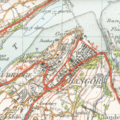Bangor, Gwynedd facts for kids
Quick facts for kids Bangor |
|
|---|---|
| Town and community | |
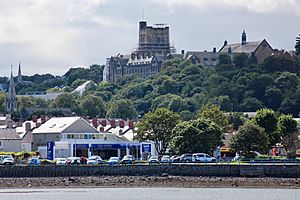 View of the Town from Porth Penrhyn in 2019 |
|
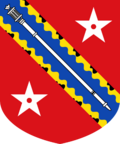 Coat of arms |
|
| Area | 2.5 sq mi (6.5 km2) |
| Population | 15,060 (Community, 2021) 16,990 (Built up area, 2021) |
| Demonym | Bangorian |
| OS grid reference | SH 580722 |
| • Cardiff | 127 mi (204 km) SSE |
| • London | 207 mi (333 km) SE |
| Principal area | |
| Ceremonial county |
|
| Country | Wales |
| Sovereign state | United Kingdom |
| Post town | BANGOR |
| Postcode district | LL57 |
| Dialling code | 01248 |
| Police | North Wales |
| Fire | North Wales |
| Ambulance | Welsh |
| EU Parliament | Wales |
| UK Parliament |
|
| Welsh Assembly |
|
Bangor is a historic city in North Wales, located in the county of Gwynedd. It's known for being the oldest town in Wales. The city is home to Bangor Cathedral, Bangor University, and the beautiful Garth Pier. Two famous bridges, the Britannia and Menai Suspension bridges, connect Bangor to the Isle of Anglesey. In 2021, about 15,060 people lived in the community of Bangor.
Contents
- History of Bangor
- City Status
- Geography of Bangor
- How Bangor is Governed
- Population and Language
- Getting Around Bangor
- Culture and Fun
- Shopping in Bangor
- Education in Bangor
- Hospital
- Sports in Bangor
- Media and Entertainment
- Bangor, Pennsylvania
- Famous People from Bangor
- Twin Town
- Images for kids
- See also
History of Bangor

Bangor began as a religious settlement in the early 6th century. A Celtic saint named Deiniol founded a monastery where Bangor Cathedral now stands. The name 'Bangor' comes from an old Welsh word for a fenced area, like the one that surrounded the first monastery. The current cathedral building has been changed a lot over hundreds of years. Even though it's not the biggest, the bishopric of Bangor is one of the oldest in the UK.
For many centuries, Bangor remained a small place. Its growth really started in the 18th century. The main mail route from London to Dublin was changed to pass through Bangor. This brought more trade and helped the town grow.
Slate and Bridges
The city's development got another boost from slate mining nearby in Bethesda. This became one of the biggest slate quarries in the world. To help transport the slate, Thomas Telford built the A5 road and the famous Menai Suspension Bridge in 1826. This bridge connected Bangor to Anglesey, making travel much easier. Later, in 1848, Bangor railway station opened, further connecting the city.
Bangor continued to grow with new industries like shipbuilding and a rise in tourism. People would even travel by steamboat from Liverpool to visit.
Schools and Modern Times
Friars School was founded in 1557. Later, in 1884, Bangor University was established. During World War II, parts of the BBC moved to Bangor to escape bombings. The BBC still has facilities in the city today.
City Status
Bangor is special because it's the only place in Wales that has kept its city status for a very long time. This is due to its ancient cathedral and special rights it was given in the past.
Bangor is one of the smallest cities in the UK. For example, in 2011, it was the third smallest city in Wales by population. It's also one of the smallest cities in the UK by land area.
Geography of Bangor
Bangor is located on the coast of North Wales, very close to the Menai Strait. This narrow stretch of water separates the island of Anglesey from the mainland of Gwynedd. The town of Menai Bridge is just across the strait.
Mountains and Suburbs
Bangor Mountain, which is 117 meters (384 feet) high, is to the east of the city. A large housing area called Maesgeirchen is also on the east side of the mountain. Another hill, known as Upper Bangor (Bangor Uchaf), divides the city center from the Menai Strait.
Bangor has two rivers. The River Adda mostly flows underground, while the River Cegin flows into Port Penrhyn. Port Penrhyn was a very important port in the 19th century. It was used to export the slate from the Penrhyn Quarry.
How Bangor is Governed
Bangor has two levels of local government: the Bangor City Council and the Gwynedd Council. The city council meets at Penrhyn Hall. In 2021, Owen Hurcum became the mayor of Bangor. They made history as the youngest mayor in Wales at 22 years old.
Population and Language
Bangor is a diverse city. Most of its residents identify as White British. However, a good number of people are from Asian or Arab backgrounds, or other ethnic groups. This makes Bangor one of the most ethnically diverse cities in Wales for its size.
In terms of religion, Christianity is the most common, but many residents also say they don't follow any religion.
Welsh Language in Bangor
Gwynedd is the county in Wales where the Welsh language is spoken the most. However, Bangor itself has become more English-speaking over time, partly because of the large number of students at the university. In 2011, about 36% of people in Bangor could speak Welsh. This was a decrease from 46% in 2001.
Even though the percentage of Welsh speakers has gone down, Welsh was the main language spoken in Bangor in the 1920s and 1930s. At that time, most homes passed the language down to their children. Bangor has always attracted people from outside Wales, including many students, which has made it a very mixed city.
Getting Around Bangor
Bangor railway station is on the North Wales Coast Line. You can catch trains from here to places like Crewe, Chester, and Holyhead. Bus services connect Bangor to nearby towns like Holyhead, Caernarfon, and Llandudno.
The A5 road runs right through the center of Bangor, connecting it to Holyhead, Shrewsbury, and London. The A55 also passes close by, offering another route to Holyhead and Chester. If you want to fly, the nearest airport with international flights is Liverpool John Lennon Airport.
Bangor is also a great place for walking and cycling. The North Wales Path, a 60-mile (97 km) coastal walking route, starts here. Several national cycle routes also pass through the city.
Culture and Fun
Music and Arts
Bangor often hosts Classical music concerts at the university. The city also has Storiel, which is a museum and art gallery located in the Bangor Town Hall. A new arts center called Pontio opened in 2015. It has a theatre and a cinema.
Bangor has hosted the National Eisteddfod of Wales, a big Welsh cultural festival, many times over the years.
Garth Pier
Garth Pier is the second longest pier in Wales, stretching 1,500 feet (457 meters) into the water. It opened in 1893 as a place for holiday-makers to stroll and enjoy the views.
Over the years, the pier faced challenges, including being hit by a ship in 1914. It was nearly torn down in 1974 because it was in poor condition. However, local people fought to save it, and it was given special protection as a Grade II Listed building. After a lot of restoration work, the pier reopened in 1988 and is still a popular spot today.
Cathedral
Bangor Cathedral is a very old and important building. It's a Grade I Listed building, meaning it's of great historical interest. People have worshipped on this site since the 6th century, but the current building dates back to the 12th century.
Theatre and Cinemas
Bangor has a modern arts center called Pontio, which opened in 2015. It includes a theatre with 344 seats and a cinema. Before Pontio, the city had Theatr Gwynedd, which closed in 2008.
In the past, Bangor had two other cinemas: The Electric Pavilion (later Arcadia Cinema) and The City Cinema. Today, the Pontio center is the main place to catch a movie.
Recreation
Bangor has two King George V fields, which are public green spaces for recreation.
Shopping in Bangor
Bangor is famous for having the longest High Street in Wales, measuring about 1.265 kilometers (0.786 miles). You can find many shops in the city center along the High Street. There are also larger retail parks on Caernarfon Road, on the edge of the city.
A well-known business, Wartski, started as a jewelry store on Bangor's High Street in 1865. The family later developed a large department store and the high-class Castle Hotel. The Wartski family were very generous to Bangor, donating land for sports fields.
Education in Bangor
Bangor is home to Bangor University and Coleg Menai, a college. The city also has several secondary schools, including Ysgol Friars, Ysgol Tryfan, and St. Gerard's School. There are many primary and infant schools too, such as Ysgol Y Faenol and Ysgol Y Garnedd.
Hospital
Ysbyty Gwynedd (Gwynedd Hospital) is located in Bangor. It's a general hospital with 403 beds, providing healthcare for the area.
Sports in Bangor
Bangor has a long history in football. The city's team, Bangor City F.C., has won the Welsh Premier League three times and the Welsh Cup eight times. They have also played in European competitions like the UEFA Champions League.
Fans also started a new club called Bangor 1876 F.C. in 2019.
Bangor is also home to the rugby union team Bangor RFC. The university also has a very successful rugby team.
Media and Entertainment
Bangor has a small BBC broadcasting center. It produces a lot of content for BBC Radio Cymru and is the main newsroom for North-West Wales. During World War II, the BBC's Light Entertainment Department even moved to Bangor.
In 1967, The Beatles famously visited Bangor for their first meeting with Maharishi Mahesh Yogi. While they were there, they learned of the death of their manager, Brian Epstein.
In 2010, BBC Radio 1 chose Bangor to host its Big Weekend concert festival. Big international stars like Rihanna, Alicia Keys, and Biffy Clyro performed in the city.
The town is also mentioned in the popular 1979 song "Day Trip to Bangor" by Fiddler's Dram.
Bangor, Pennsylvania
Did you know there's another town called Bangor in the United States? Bangor, Pennsylvania got its name from Bangor, Gwynedd. It was settled around 1760 by Robert M. Jones, who came from Bangor, Wales. He helped develop the slate industry there. You can still see slate quarries in the American town, and there's even a statue of Robert M. Jones in the town center.
Famous People from Bangor
Many interesting people have connections to Bangor:
- Duffy (born 1984), a famous singer-songwriter.
- Owen Hurcum (born 1997), a politician and former mayor of Bangor.
- Sasha (born 1969), a well-known DJ and record producer.
- Ben Roberts (1950–2021), an actor known for The Bill.
Sports Stars
- Wayne Hennessey (born 1987), a football goalkeeper who has played for Wales.
- Owain Tudur Jones (born 1984), a footballer who also played for Wales.
- Alex Thomson (born 1974), a record-breaking solo sailor.
Twin Town
Bangor is twinned with the town of Soest in Germany.
Images for kids
See also
 In Spanish: Bangor (Gales) para niños
In Spanish: Bangor (Gales) para niños


